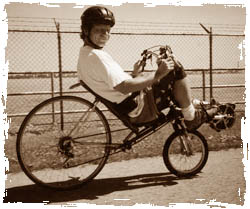The problem with the bicycle is that people in North America are in love
with their cars. The bicycle has always come in second. This fact may be a
hurdle for those looking to make inroads in the bicycle industry.
Another pothole for would-be designers is that the design of the bicycle
has changed little in the past 100 years. That's according to university professor
Ross Petty. Riders have generally been very happy with the design of the bicycle,
says Petty. He has studied bicycle culture. The double-diamond design is standard
across the nation.
Brady O'Hare is a designer in Washington. He agrees that the bicycle industry
can be stagnant. He says other than different colors and steels, the bicycle
has remained the same. However, his company is going in a new direction.
The purpose of his company's new design is to ease discomfort of the human
back.
The company's design suspends the rider rather than the bike. This lessens
back pain, reduces muscle fatigue, improves aerodynamics and increases pedal
efficiency. And it's all thanks to the bike designers.
Another innovation in the industry is called the recumbent bike. The recumbent
bike, says Petty, looks like a sunbathing chair that you would recline on
by the pool -- only it has pedals. Although it has been around since the 1930s,
says Petty, the recumbent has been slow to catch on. It enjoyed somewhat of
an upswing in the 1970s.
Steve Robson designs recumbent bikes, so he is glad to see them making
waves lately. He explains how he became hooked: "I never really liked the
road bike riding position. When I sat down in a recumbent for the first time,
I knew it was for me."
At one time, when Robson rode his recumbent, people looked at him like
he was riding a UFO. Now he sees other recumbent bikers pedaling the streets.
 |
| It's the job of a bike designer to come up with innovative ways of
building these two-wheeled vehicles. |
| Photo by: Scott Ertel |
O'Hare perfected his skills with industrial design and mechanical engineering
classes in college. He recommends that others do the same. O'Hare also worked
in bike shops, building frames and molds before working as a designer.
"Having excellent mechanical skills is needed," says Robson. "I learned
this by doing all my own work on my bikes long before designing recumbents."
Angela Owens agrees. Although Owens didn't set out to become part of the
bicycle industry, she ended up working for a company that designs parts for
manufacturers. Her background in CAD, drafting and modeling helped her score
her current position.
"Be creative, but know your manufacturing capabilities, meaning don't design
something impossible to build," she advises. "Get to know as much stuff about
bikes as possible. Work in a bike shop doing grunt work, or as a mechanic."
Mark Schroeder has worked as an engineering director for a large bicycle
manufacturer. Schroeder says he got his position because of his engineering
degree, hands-on knowledge of bikes and manufacturing knowledge and hard work.
Schroeder's advice is to be a go-getter because the bike industry is small
and competitive. At least with an engineering degree in hand, new graduates
can find jobs elsewhere.
California bike designer Tony Ellsworth tells those interested in bike
design, "Ride. Ride everything. Ride everywhere. Critique and evaluate the
characteristics of everything you ride."
Ellsworth also says future designers should have a background in CAD, solid
modeling and metallurgy. "After about seven to 10 years [of adjusting and
tinkering], you're going to have a great product. Then you have to convince
others of how great it is. It is a labor of love."
"It's very tough [breaking into the industry]," says designer Victor Chang.
"It's the typical catch-22: no one wants to hire someone without experience,
but you can't get experience unless someone is willing to hire you."
Chang says that besides a solid engineering background, cycling companies
look for employees who are cyclists. His final warning: "Don't get into the
cycling business unless you really love doing it."
Richard Schwinn is a Wisconsin assistant designer. He agrees with Chang.
"It is very tough to find design work. Our industry is consolidating and employment
by the big brands is falling. The number of bikes sold has yet to match what
was sold in the '70s."
Further, Schwinn says, the number of people competing for these jobs is
much larger than the industry can bear. "There's a long line of engineers
who become bike enthusiasts and decide they want to get into the business."
As pollution and congestion become bigger problems in Europe, Mexico and
Japan, Petty suggests bikes may gain popularity. In addition, in the U.S.,
one trend that may push the use of bicycles is the conversion of old railroad
lines to bike trails, called the Rails to Trails movement.
However, if you do decide to go into bicycle design, expect a rocky road
ahead.